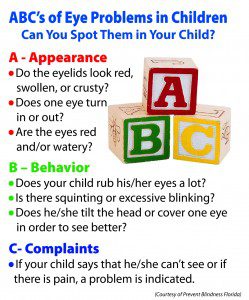Did you know that 80% of all learning in a child’s first 12 years is through their visual system?


It’s true that decreased vision can significantly affect educational success, athletic ability, and even personality and social interaction. Children are even sometimes mislabeled as “slow learners” when poor vision prevents a child from seeing school work clearly. Even if your child doesn’t complain about not seeing well, don’t assume that there are no visual problems. Your children have no reason to believe that what they are seeing is different from what everyone else sees, yet studies have found that 1 in 4 children, ages 5 to 12, have an undiagnosed vision problem. This sobering statistic underscores the fact that annual eye exams are crucial.
The American Optometric Associates (AOA) has the following recommendations for kids having their eyes examined:
• Infants should have their first comprehensive eye exam at 6 months of age, then again at ages 3 and 5
• School-age Children that don’t wear glasses should have a comprehensive eye exam every 2 years
• Children who wear glasses or contact lenses should be examined annually
What Does the Eye Doctor Check For?
The eye doctor will first evaluate your child’s eyes for a refractive error, which refers to several conditions including nearsightedness, farsightedness and astigmatism. A prescription for eyeglasses or contact lenses may be needed to correct the vision. The doctor also checks for eye diseases and other problems that could lead to vision loss. Among the conditions he/she will look for are Amblyopia (often called Lazy Eye), Strabismus (Crossed eyes), Ptosis (drooping of the upper eyelid), and Glaucoma. If caught early, these problems can be successfully treated, especially if detected before the age of 5. It is never too early to be screened for common eye problems—childhood glaucoma occurs in 1 out of every 8,000 children in the US, and some babies are actually born with glaucoma!
Kids, Computers, Smartphones and Dry Eye Disease
Computer use is universal these days as books take a back seat to screens. You don’t need to look far to be aware of the overwhelming number of kids glued to their smartphones. Unfortunately all this wonderful technology comes with a cost that is above and beyond the billing from a service provider. The eyes and brain react differently to electronic characters on a computer screen than they do with characters on a printed page. Healthy eyes can easily maintain focus on print, while characters on a digital device do not have the same contrast or well-defined edges. The eyes have to strain to maintain focus on a digital screen, and there is usually decreased blinking. This combination of factors causes the eyes to dry out, and usually experience fatigue and/or burning. A recent study found that increased duration of smartphone use, in particular, is a significant risk factor for having dry eyes.
The Importance of Sunglasses for Kids
Before children reach the age of 18, they have already had approximately ½ of their life’s exposure to the sun. Blocking the sun’s rays from damaging the eyes should be a parent’s priority, beginning at a very early age. In fact, we recommend that kids as young as 6 months old should be wearing sunglasses. Specifically polarized polycarbonate lenses with both UVA and UVB protection should be fit. You can find some great styles for your child at all The Optical Gallery locations.
Other Vision Safety Tips for Kids
Teach children these protective rules:
• Wear safety goggles during sports, when using chemistry sets or power tools
• Don’t run with or throw sharp objects
• Laser pointers are not toys and should not be directed at anyone’s eyes
Insuring that your child’s vision is the best that it can be is going to provide a great start for the new school year.
The Eye Associates
Richard E. Hector, MD
Robert S. Friedman, MD
Cathleen McCabe, MD
Brian Foster, MD
Todd Berger, MD
Jeffrey Kasper, MD
Ahmad Tarabishy, MD
Scott B. Han, OD
Michael Camp, OD
Edwin Detweiler, III, OD
Lori Ann Long, OD
Robert Rego, OD
Toll Free: 1-866-865-2020
www.Sight4Life.com
WEST BRADENTON:
6002 Pointe West Blvd
(1 block south of Blake Medical Center off 59th St West)
EAST BRADENTON:
7230 55th Avenue East
(12 Oaks Plaza at SR 70 & I-75)
ELLENTON:
7915 US Hwy 301 North, # 101
(Harris Professional Center,
corner Hwy 301 N & 80th Ave E)
SARASOTA:
2111 Bee Ridge Road
(South of Southgate Mall off US 41)
SUN CITY CENTER:
3894 Sun City Blvd
(on SR 674 across from Burger King)
WEST BRADENTON:
Dermatology & Hearing only
2101 61st Street West
 Southwest Florida's Health and Wellness Magazine Health and Wellness Articles
Southwest Florida's Health and Wellness Magazine Health and Wellness Articles

